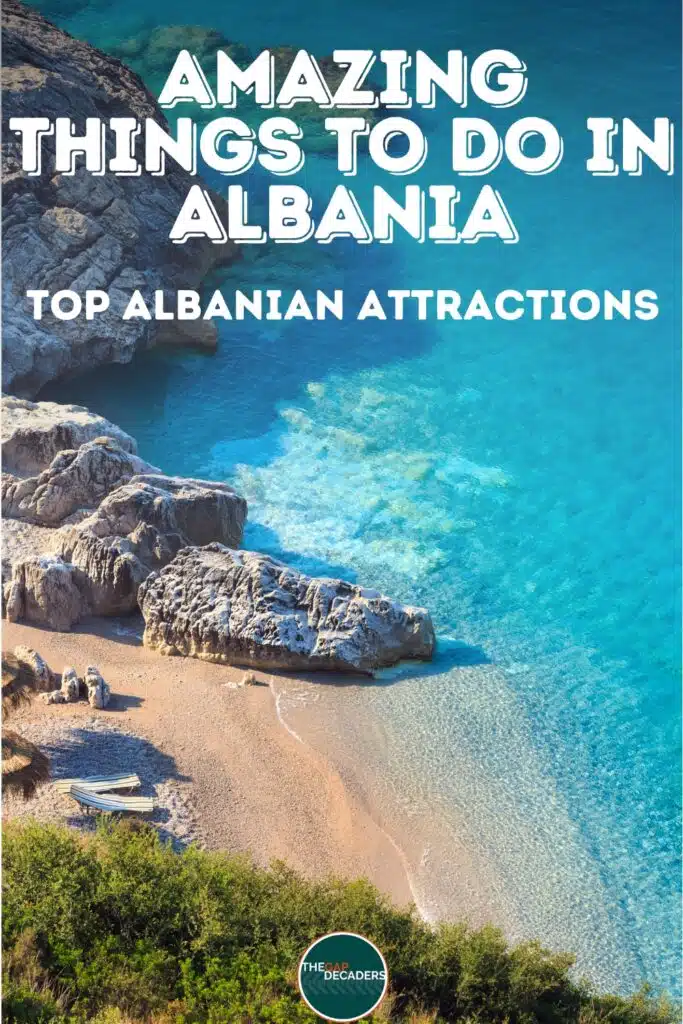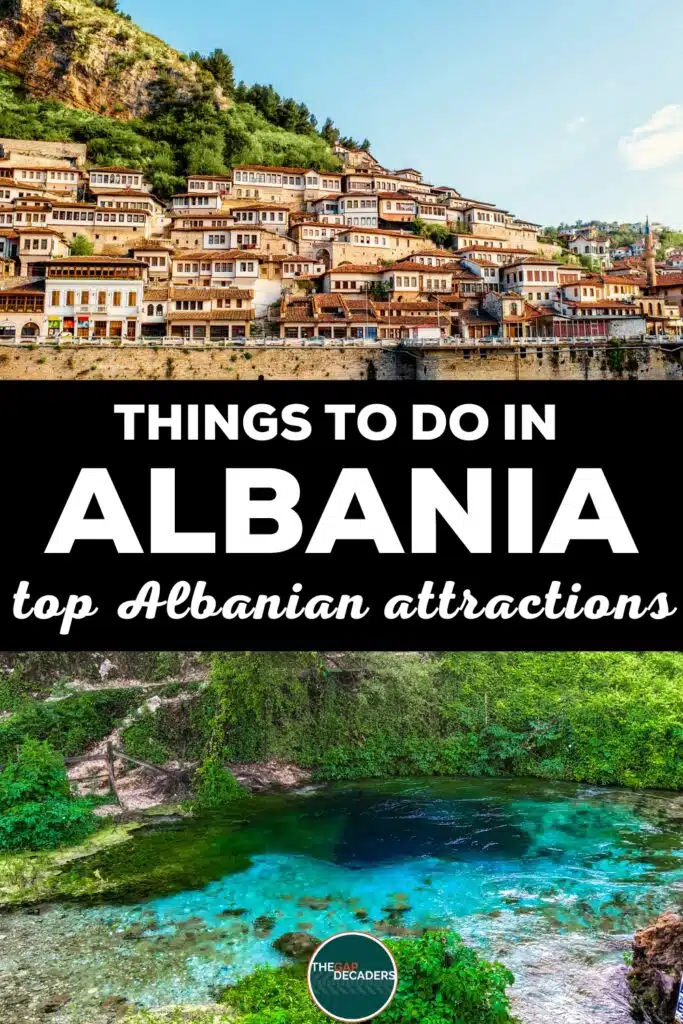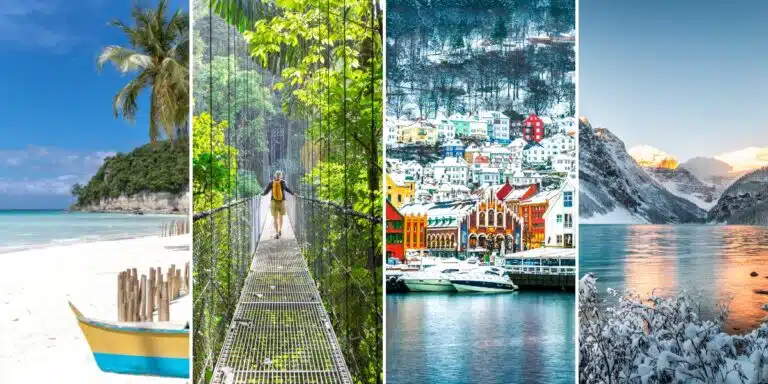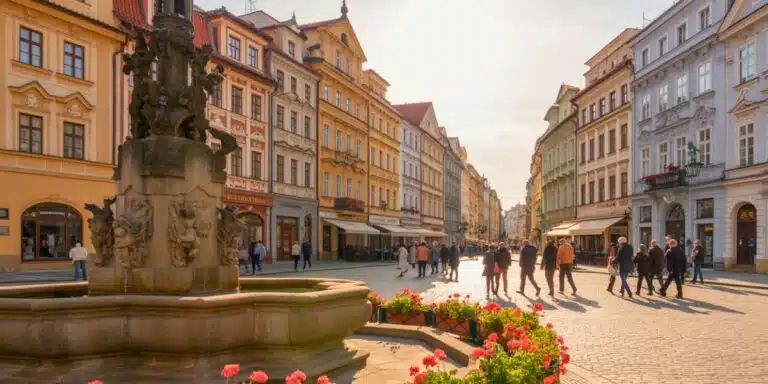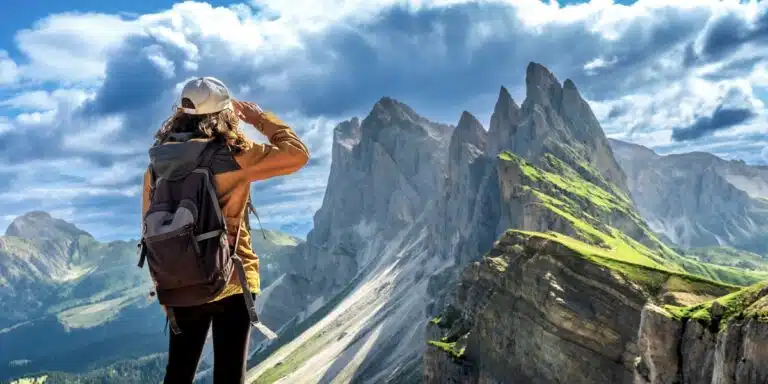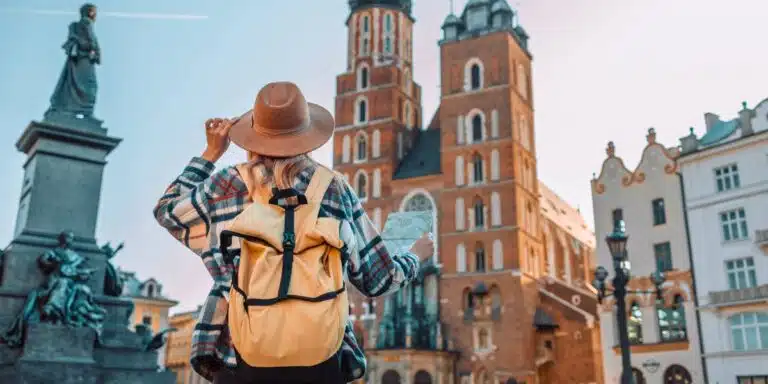This post may contain affiliate links, from which we earn an income. Click here to read our affiliate policy.
Top Albania travel attractions & hidden gems
Dreaming of an unforgettable adventure that combines rugged beauty, rich history, and authentic Balkan charm? It’s time to visit Albania – the sparkling gem of Eastern Europe that’s just waiting to be discovered! From the sun-soaked shores of the Albanian Riviera to the ancient ruins of Butrint, this destination is a must-have on your Albania bucket list.
Whether you’re crafting the perfect Albania itinerary or simply seeking the most spectacular Albania travel places to visit, we’ve got you covered. Let us guide you through a breathtaking Albania vacation filled with culture, nature, and local flavors.
From hidden mountain villages to bustling seaside towns, our Albania travel guide will ensure you capture the best of the Balkans. Your epic Albania experience starts here!

1. Explore the Fascinating Gjirokastër Castle
Dating back to the 12th century, Gjirokastër Castle has witnessed countless power struggles, cultural evolutions, and architectural enhancements over the centuries and is a must visit for your Albania travel itinerary.
The castle was expanded by the Ottoman Empire in the early 19th century under Ali Pasha of Tepelena, adding layers of history to its already impressive structure.
What to Expect
Intricate architecture: Explore massive stone walls, watchtowers, and secretive passageways. The castle’s design reflects a blend of Byzantine and Ottoman influences, with fortified corridors that echo stories of ancient conflicts and power.
Military Museum: Visit the on-site museum dedicated to Albania’s military history, featuring artifacts, weaponry, and even a captured American spy plane from the Cold War era – a unique piece of history that adds to the castle’s mystique.
Gjirokastër National Folklore Festival: If you’re lucky enough to visit during this vibrant event held every five years, you’ll experience traditional Albanian music, dance, and costume performances within the atmospheric castle grounds.
Getting to Gjirokastër
From Tirana: A drive of approximately 3 hours or a bus ride is the most common way to reach Gjirokastër. Buses leave regularly from Tirana’s South Bus Station.
From the Albania Riviera: Gjirokastër is conveniently located about 1.5 hours from Sarandë, making it a great day-trip option.
Local Delicacy to Try
No visit to Gjirokastër is complete without savoring the local delicacy, tavë kosi – a delectable baked dish of lamb and creamy yogurt infused with eggs and rice. This hearty meal is not only delicious but also carries the essence of the region’s culinary tradition. Enjoy it at local restaurants like Taverna Kuka for an authentic experience.
Gjirokastër Travel Tips
Guided tours available: To dive deeper into the castle’s history, consider hiring a local guide who can reveal hidden stories and fascinating facts.
Wear comfortable shoes: The castle’s grounds are vast, and some paths are uneven.
Photography alert: The views from the castle are breathtaking at sunset, so make sure your camera is ready!
RELATED POST: Albanian Roadtrip: Epic One Week Itinerary
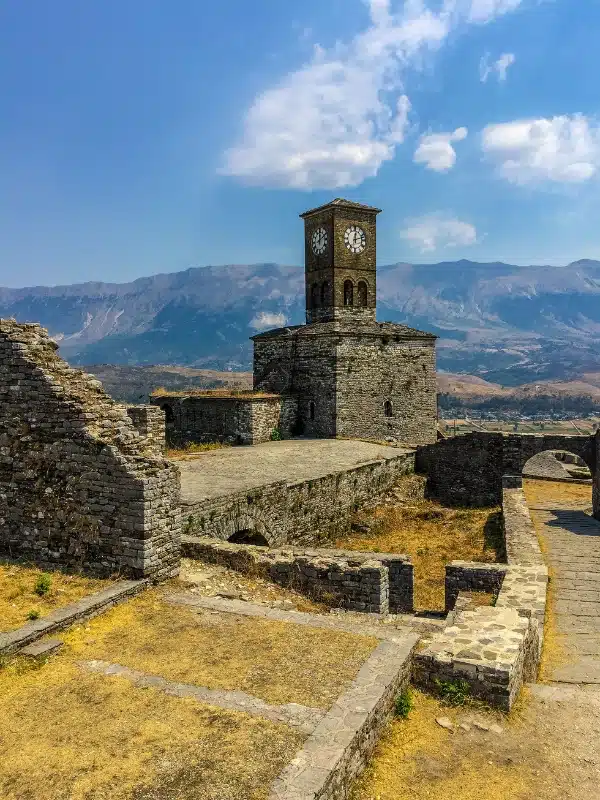
Make sure you have travel insurance you can trust for Eastern European travel. We recommend True Traveller for their 5-star TrustPilot reviews, variety of cover options, best activities cover as standard, great prices, and excellent service.
2. Relax on the Gorgeous Beaches of the Albanian Riviera
The Albanian Riviera is a dream destination for beach lovers, offering a stunning mix of crystal-clear waters, rugged coastline, and charming coastal villages.
This breathtaking stretch along the Ionian Sea is known for its pristine, secluded beaches, lively nightlife, and incredible culinary experiences.
What to Expect
Ksamil Beach: Located near the Greek border and just a short drive from Sarandë, this beach captivates visitors with its powdery white sand and shimmering turquoise waters. The calm, shallow bays are perfect for families and those looking for a tranquil swimming experience. Nearby, small islands are accessible by boat or even a short swim, providing a sense of private paradise.
Dhërmi Beach: A unique combination of relaxation and adventure. By day, unwind on sunbeds along the expansive pebbly shore or explore hidden coves nestled between dramatic cliffs. By night, Dhërmi comes alive with vibrant beach bars and open-air clubs where you can dance under the stars.
Himarë Beach: Perfect for a laid-back seaside experience with friendly local tavernas serving fresh seafood and regional specialties. Its calm waters and charming village vibe make it an excellent spot for relaxation.
Gjipe Beach: An adventure lover’s paradise. To reach this hidden gem, enjoy a hike through a scenic canyon that opens up to a secluded beach with sparkling azure waters. A great spot for those seeking pristine beauty away from the crowds.
Jalë Beach: Popular among younger crowds for its energetic nightlife, this beach also offers calm waters and stunning views by day.
Getting to the Albanian Riviera
From Tirana: Fly into Tirana International Airport and either rent a car or take a bus for a four-to-five-hour scenic drive along the coast. The drive over the Llogara Pass offers spectacular panoramic views of the Ionian Sea.
The Albanian Riviera startes in Vlorë but is most easily accessed from Sarandë, also called Saranda locally. You can reach Sarandë via a ferry from Corfu (a 30-minute ride) or by bus from Tirana. From Sarandë, many of the Riviera’s most beautiful beaches are less than two hours away by car.
Local Transport: Buses and shared taxis run frequently between coastal towns, but renting a car provides greater flexibility, especially for visiting more secluded beaches like Gjipe.
Local Delicacy to Try
As you bask in the sun, indulge in a plate of qofte të fërguara, a delicious local delight of fried meatballs seasoned with garlic, herbs, and spices. Typically served with fresh bread, creamy yogurt, and sometimes a side of roasted vegetables, this hearty dish is best enjoyed seaside at local eateries. For a truly authentic experience, pair it with a glass of raki, Albania’s traditional fruit brandy.
Albanian Riviera Travel Tips
Prepare for limited facilities: At more remote beaches it’s just you, the sand and the sea. Bring water and snacks if you plan to spend the day.
When to visit: During the shoulder seasons (May–June or September) for warm weather, tranquil beaches, and fewer tourists.
Water shoes required!: Many beaches are pebbly, especially around Sarandë and Himara so bring water shoes for added comfort.
RELATED POST: Beautiful Albania: 16 Most Scenic Places to Visit
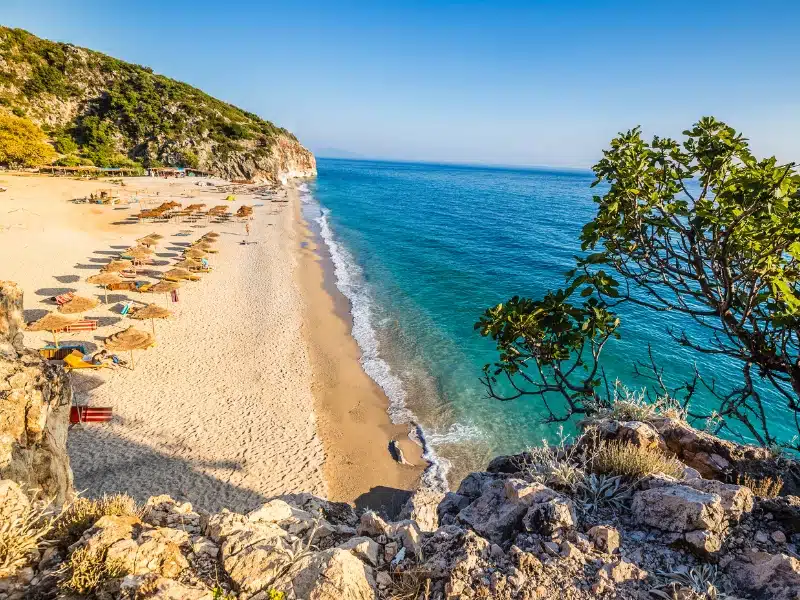
3. Discover History at the Ancient Site of Butrint
For history aficionados, Butrint offers a captivating journey through time, revealing layers of civilizations that have thrived along the Ionian Sea’s shores.
Declared a UNESCO World Heritage Site in 1992, this ancient city tells of the rise and fall of Greek, Roman, Byzantine, Venetian, and Ottoman empires over the past 2,500 years.
What to Expect
Archaeological marvels: Explore remarkably well-preserved ruins including a Greek theatre, Roman baths, Byzantine basilica, and the Venetian tower. The Amphitheatre, dating back to the 3rd century BC, is particularly impressive, with views of the surrounding wetlands that add to the site’s mystique.
Butrint Museum: Located within the Venetian Castle, this museum houses fascinating artifacts excavated from the site. It provides detailed context about Butrint’s historical significance, making it an essential stop during your visit.
Walking trails: Wander along shaded paths winding through the lush greenery of Butrint National Park. The park’s diverse ecosystems include wetlands, freshwater lakes, salt marshes, and dense forests, making it a paradise for nature enthusiasts.
Cultural festivals: Keep an eye out for occasional cultural events and open-air performances held at the ancient amphitheatre, particularly during the summer months. These festivals often feature traditional music and dance, bringing the site’s history to life.
Getting to Butrint
From Sarandë: The most convenient way to reach Butrint is by taking a bus from Sarandë, which operates regularly and takes about 30 minutes. Alternatively, you can hire a taxi or rent a car for more flexibility.
By ferry from Corfu: Visitors coming from Corfu, Greece, can take a short ferry ride to Sarandë and then continue their journey by bus or taxi to Butrint.
On foot or bicycle: For the adventurous, consider renting a bicycle from Sarandë or hiking along the scenic coastline—just be prepared for the heat if you visit during summer.
Local Delicacy to Try
As you explore the ancient ruins, indulge in a slice of bakllavë, a beloved Albanian dessert made of thin layers of filo pastry, finely chopped nuts, honey, and spices. Its rich, syrupy sweetness makes it the perfect energy boost as you traverse the historic site.
Butrint Travel Tips
Avoid the crowds: Visit early in the morning or late in the afternoon to avoid the midday heat and day trippers.
Bring the right gear: Wear comfortable walking shoes as the ruins are expansive, and some areas have uneven terrain. Bring water, sunscreen, and a hat, especially during the hot summer months.
Buy a guided tour: If you want deeper insights into Butrint’s complex history. Alternatively, audio guides are available at the entrance.
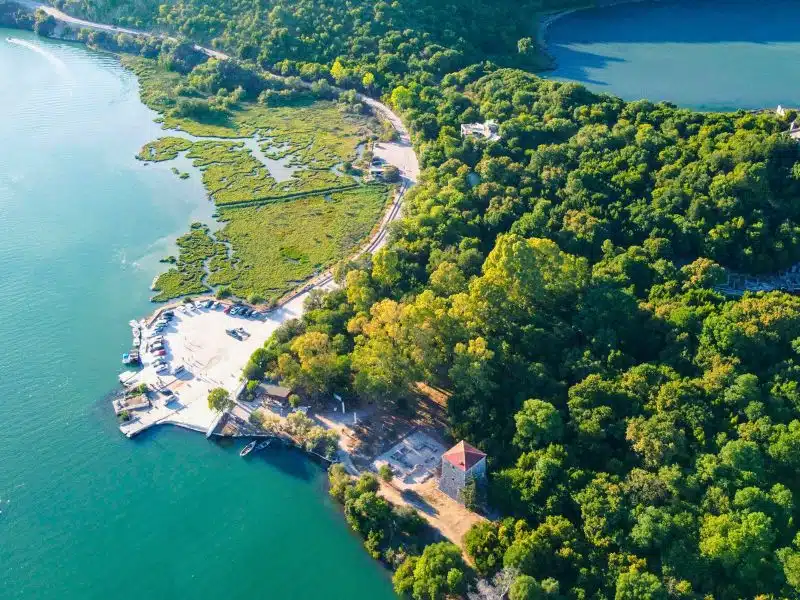
4. Hike the Accursed Mountains for Breathtaking Views
The so-called Accursed Mountains, or Albanian Alps, are a true paradise for hikers, adventure seekers, and nature enthusiasts. With jagged peaks, verdant valleys, and pristine rivers, this remote region offers some of the most stunning and untouched landscapes in all of Europe.
What to Expect
Spectacular trails: The most popular and scenic trek is the Valbona to Theth hike, a 17-kilometer trail that winds through breathtaking mountain passes, lush forests, and alpine meadows. It’s a moderately challenging trek suitable for most fitness levels and usually takes between 6 to 8 hours to complete.
Picturesque villages: Valbona and Theth are the two main starting points. Valbona is known for its serene river valley and dramatic mountain views, while Theth boasts charming stone houses, the iconic Lock-In Tower, and the Blue Eye of Theth, a crystal-clear natural spring.
Rich biodiversity: The region is part of the Bjeshkët e Namuna National Park, home to a variety of wildlife including brown bears, lynxes, and golden eagles. Birdwatchers and nature enthusiasts will find this area particularly rewarding.
Local culture: The remote mountain villages are home to communities that have preserved centuries-old traditions. Engaging with locals provides unique insights into their way of life, folklore, and hospitality.
Getting to the Albanian Alps
From Shkodër to Valbona: Travel from Shkodër to Valbona typically involves a scenic journey by bus or minivan to the town of Fierza, followed by a spectacular ferry ride across Lake Koman. The ferry journey, which takes about 2.5 hours, offers breathtaking views of steep gorges and emerald waters.
From Shkodër to Theth: Theth is now more accessible thanks to a newly paved road that allows for direct car access from Shkodër (approximately 2.5 hours by car). For a more traditional experience, you can still opt for a bus or shared taxi.
Inter-village travel: Many travelers choose to hike from Valbona to Theth or vice versa. At the end of the trek, shared taxis are available to return you to Shkodër or onward to your next destination.
Local Delicacy to Try
During your mountain trek, take a moment to try kulaç, a traditional soda bread often served warm alongside cheese, honey, or meat dishes. This dense and hearty bread is a staple of Albanian mountain cuisine, perfect for refueling during a long hike. You can find freshly baked kulaç in local guesthouses or restaurants in Valbona and Theth.
Albanian Alps Travel Tips
Accommodation: Guesthouses in both Valbona and Theth offer warm hospitality and traditional meals. Making reservations in advance is recommended, especially during peak season.
Best time to visit: The ideal time for hiking in the Albanian Alps is from May to September when the weather is warmer, the road is open and the trails are accessible.
Packing essentials: Bring sturdy hiking boots, layered clothing, rain gear, a hat, and sunscreen. Even in summer, temperatures can drop rapidly at higher altitudes.
RELATED POST: Driving in Albania: Essential Tips for an Amazing Trip
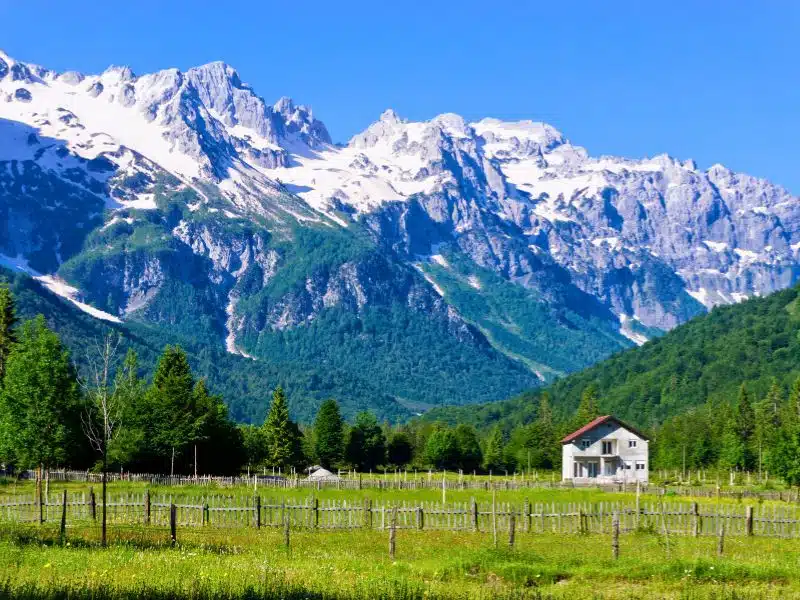
5. Take the Lake Koman Ferry
An undisputed highlight of any Albanian adventure is the Lake Koman ferry ride. This is an unforgettable journey through one of the most scenic waterways in Europe which connects the towns of Koman and Fierzë, and serves as a gateway to the Valbona Valley National Park.
Often compared to the Norwegian fjords, this boat trip meanders through narrow gorges, lush green hills, and dramatic cliffs, offering breathtaking views at every turn. The ferry connects the towns of Koman and Fierzë, and serves as a gateway to the Valbona Valley National Park.
What to Expect
Stunning scenery: The journey takes approximately 2.5 to 3 hours and winds through a series of narrow, fjord-like passages framed by towering mountains. The lake’s emerald waters glisten under the sun, and the landscape changes from steep cliffs to verdant valleys as you travel.
Boat options: There are several ferry options, ranging from public ferries to private boats and car ferries. The most popular is the “Dragobia” or “Alpin” ferry, which is ideal for foot passengers and small vehicles.
Wildlife spotting: Keep an eye out for eagles soaring above and shepherds tending to flocks on the steep hillsides. The region is teeming with diverse wildlife, adding to the sense of immersion in nature.
Community connection: The ferry is not just a tourist attraction; it is also an essential transport link for local villagers, giving you a glimpse into daily life in this remote region.
Getting to the Koman Ferry
From Shkodër to Koman: Start your journey by taking a minibus from Shkodër to the Koman ferry terminal, a 2-hour drive through winding mountain roads. It’s recommended to leave early in the morning to catch the first ferry departure.
Ferry ride to Fierzë: The ferry departs in the morning and covers approximately 34 kilometers through the scenic canyon. Reservations are highly recommended during the peak summer months.
Continue to Valbona: Upon arrival at Fierzë, you can take a bus or taxi to Valbona, the perfect base for exploring the Albanian Alps. Many travelers make this journey part of a three-day, two-night loop, combining the ferry with the stunning Valbona to Theth hike.
Returning to Shkodër: After the hike, you can take a shared taxi or bus from Theth back to Shkodër, completing the loop. Most guesthouses in Valbona and Theth can help arrange transport.
Local Delicacy to Try
While on the ferry or exploring the nearby villages, make sure to sample kryelane, a traditional sweet bread from the Albanian Alps. Made of flour, butter, and sugar or honey, this simple yet delicious treat is one of the oldest traditional dishes in the region. Its soft texture and mildly sweet flavor make it a perfect snack during your journey. You can find it at guesthouses and local bakeries around Valbona and Theth.
Lake Koman Ferry Travel Tips
Combine with a hike: Many travelers make this ferry trip part of the Valbona-Theth hiking loop for a complete outdoor experience.
Book ahead: Ferries fill up quickly during peak seasons (June to September), so booking your spot in advance is highly recommended.
Bring snacks and water: There are limited food options on the ferry, so pack refreshments for the trip.
Pack light: Space on the ferry can be limited, especially if traveling with a vehicle.
Photography: Don’t miss the deck views – the landscapes are some of the most photogenic in Albania.
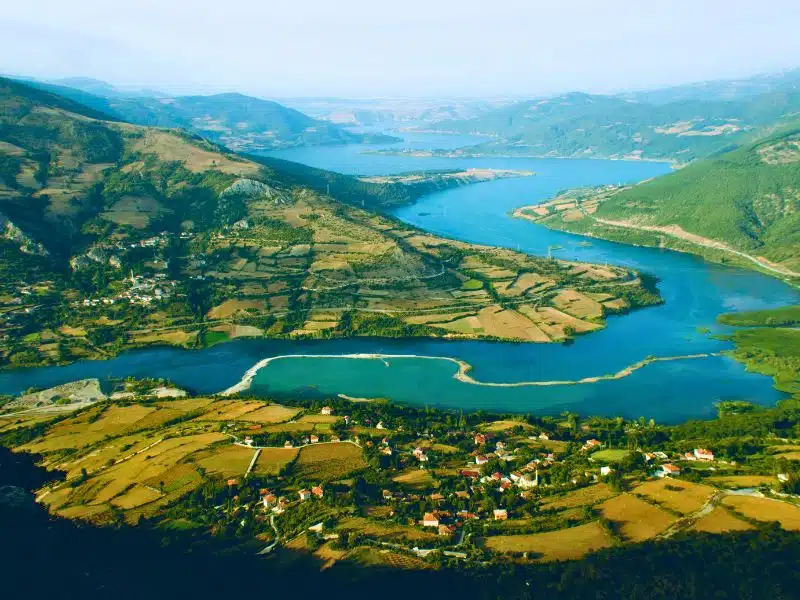
6. Explore the Creative Pulse of Tirana
Tirana, the heart of Albania, is a vibrant capital where history meets contemporary creativity. This dynamic city has undergone a remarkable transformation over the last few decades, blossoming into a hub of art, culture, and innovation. From its colorful facades to its bustling cafes and burgeoning art scene, Tirana offers a perfect blend of tradition and modernity.
What to Expect
Art and culture: Stroll through the city’s art galleries and museums, including the National Art Gallery, where you can explore both classic and contemporary Albanian art. For a more unconventional experience, visit Bunk’Art 1 and Bunk’Art 2, underground museums housed in massive Cold War-era bunkers showcasing the country’s complex political history through multimedia exhibitions.
Street art: Tirana’s urban landscape is a canvas of creativity. The city is famous for its vibrant street art, with murals and graffiti transforming once-drab communist buildings into lively, colorful masterpieces. The area around Pazari i Ri (New Bazaar) and the Blokku District are particularly rich with eye-catching art.
Cultural events: Attend the annual Tirana International Film Festival, Albania’s foremost cinematic event that draws filmmakers from around the world. The festival showcases independent films, documentaries, and animations, providing a fascinating insight into both local and international cinema.
Nightlife and cafes: Tirana’s nightlife is thriving, especially in the Blokku District, once reserved exclusively for communist elites. Now, it’s a trendy area filled with cafes, bars, and clubs that stay lively until the early hours.
Getting to Tirana
By Air: The easiest way to reach Tirana is to fly into Tirana International Airport Nënë Tereza, located 17 kilometers from the city center. Taxis and buses are readily available to take you into the heart of Tirana, with buses departing every 30 minutes.
By Bus: If you’re traveling from neighboring countries like Kosovo, Montenegro, or North Macedonia, buses run regularly to Tirana. The main bus station, Terminali i Autobusëve të Jugut dhe Veriut, serves both domestic and international routes.
By Car: Renting a car is also an option, providing flexibility to explore the city and its surroundings. Roads are generally in good condition, though traffic in the city center can be heavy during peak hours.
Local Delicacy to Try
While soaking in Tirana’s artistic atmosphere, indulge in tavë kosi, one of Albania’s most beloved traditional dishes. This savory casserole is made with lamb, yogurt, eggs, and rice, baked until golden and creamy.
It’s a comforting and hearty meal that captures the essence of Albanian cuisine. You can find this specialty at popular restaurants like Mullixhiu and Oda, both offering delicious, authentic versions of this dish.
Tirana Travel Tips
Language: While Albanian is the official language, many young people speak English, Italian, or Greek, particularly in popular tourist areas.
Best time to visit: Visit during the spring (April–June) or autumn (September–November) when the weather is mild and cultural events are plentiful.
Accommodation options: From luxury hotels to charming boutique stays, Tirana offers a wide range of accommodation options, especially around the city center and Blokku District.
Getting around: Tirana is a walkable city, but taxis and buses are also convenient options. Bike rentals are becoming increasingly popular, especially around the Grand Park of Tirana (Parku i Madh i Tiranës).
RELATED POST: Is Tirana Worth Visiting? Top Reasons to Explore the Lively Albanian City
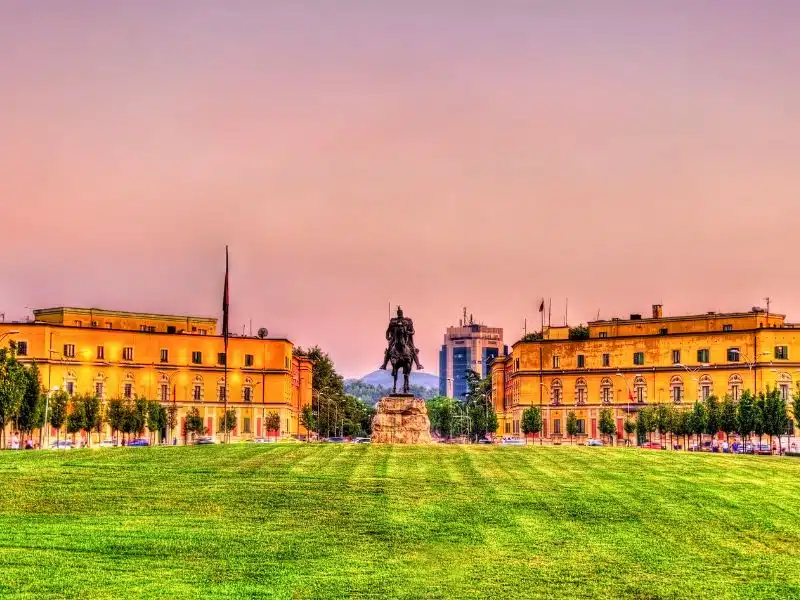
Looking for the best SIM card deals in Europe for your trip? Check out our guide to the best data SIMs in Europe and get the best deal for your trip to Albania.
7. Step Back in Time in the Town of Krujë
Nestled on the slopes of Mount Krujë, this charming town is a living time capsule that transports visitors to Albania’s medieval era. Known as the birthplace of Albania’s national hero, Skanderbeg, Krujë played a pivotal role in the country’s resistance against the Ottoman Empire during the 15th century.
What to Expect
Krujë Castle: Perched atop a rocky hill, Krujë Castle offers sweeping views of the Adriatic Sea and the surrounding countryside. Dating back to the 5th or 6th century, it is most famous for its association with Gjergj Kastrioti Skanderbeg, who successfully defended Albania from the Ottomans for over two decades. Explore the Skanderbeg Museum, housed within the castle, which offers fascinating insights into the hero’s legacy through historical artifacts, paintings, and models.
Ethnographic Museum: Located within the castle complex, this museum provides a glimpse into traditional Albanian life. Housed in a beautifully restored Ottoman-style house, it features exhibits of handicrafts, traditional clothing, furniture, and household items.
Old Bazaar (Pazari i Vjetër): Stroll through the cobbled streets of Krujë’s bustling bazaar, where artisans craft and sell a wide array of handmade goods. From silver filigree jewelry and carpets to wood carvings and antiques, this market is a treasure trove of local craftsmanship. It’s also an excellent place to purchase souvenirs and authentic Albanian gifts.
Getting to Krujë
From Tirana: Krujë is conveniently located just 35 kilometers north of Tirana, making it an easy day trip from the capital.
By Car: The drive takes approximately 1 hour and offers beautiful views of the Albanian countryside.
By Bus: Buses and minibuses (furgons) leave regularly from Tirana’s Regional Bus Terminal. The journey takes around 1.5 hours.
From Durrës: A 1.5-hour drive or bus ride makes Krujë accessible from the popular coastal city of Durrës.
Local Delicacy to Try
No visit to Krujë is complete without tasting mantia, a savory dish of delicate dumplings filled with meat, onions, and spices, then baked until golden brown and served with yogurt or a tangy tomato-based sauce. You can find authentic mantia at local eateries within the bazaar or nearby restaurants such as Restaurant Bardhi, known for its traditional dishes.
Krujë Travel Tips
Take your time: The bazaar is best enjoyed at a leisurely pace – browse the shops, chat with artisans, and soak in the medieval atmosphere.
Best time to visit: Spring and autumn are ideal, offering mild weather perfect for exploring the castle and bazaar.
Wear comfortable shoes: The cobblestone streets of the bazaar and castle grounds can be uneven, so be sure to wear sturdy footwear.
Photography opportunities: Bring your camera for panoramic views from the castle and picturesque scenes within the bazaar.
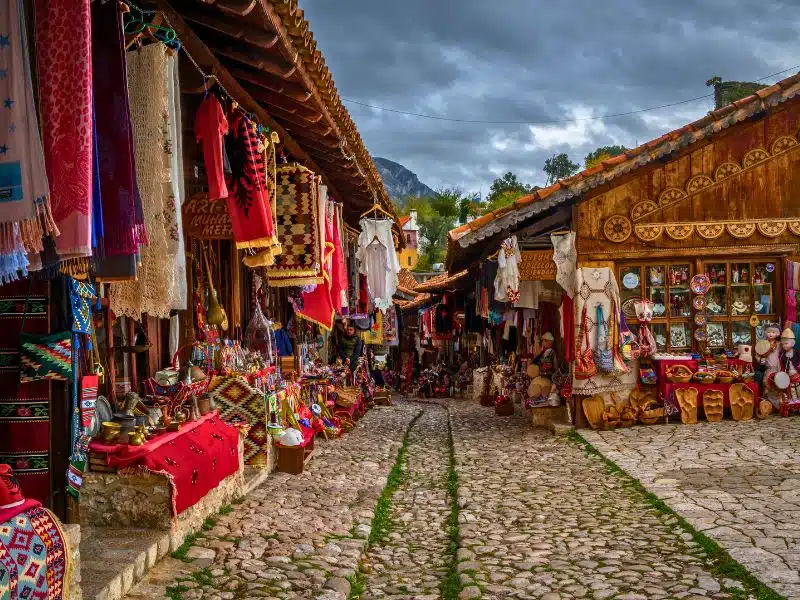
8. Experience Warm Albanian Hospitality in Gjirokastër
Gjirokastër is not only known for its impressive castle but also for its genuine and welcoming hospitality. This UNESCO World Heritage Site offers a deep dive into Albania’s rich culture and traditions, providing visitors with authentic interactions that reveal the warmth of its people.
What to Expect
Charming stone-crafted homes: Gjirokastër is often called the “City of Stone” due to its Ottoman-era architecture, with distinctive stone-roofed houses climbing the hillsides. Visiting local homes, particularly those that have been converted into museums or guesthouses, provides a glimpse into traditional Albanian life.
Friendly locals: Engage with Gjirokastrians who are often eager to share their stories, customs, and culinary traditions. Whether you’re wandering the cobblestone streets or relaxing in a cozy taverna, expect friendly conversations and generous hospitality.
Guesthouse stays: Experience true Albanian hospitality by staying in local guesthouses. Many families open their doors to travelers, offering home-cooked meals, cozy accommodations, and invaluable insights into Gjirokastër’s culture and history.
Getting
From Tirana: A drive of approximately 3 hours or a bus ride is the most common way to reach Gjirokastër. Buses leave regularly from Tirana’s South Bus Station.
From the Albania Riviera: Gjirokastër is conveniently located about 1.5 hours from Sarandë, making it a great day-trip option.
Local Delicacy to Try
While exploring Gjirokastër, don’t miss out on tasting pispili, a unique dish made of cornbread and leeks, often enhanced with feta cheese or spinach for extra flavor. This hearty, comforting dish is a staple in the region and can be sampled in local restaurants, where it’s often made following family recipes passed down through generations.
Gjirokastër Travel Tips
Wear comfortable shoes: The hilly terrain and cobblestone streets of Gjirokastër can be challenging to navigate, so comfortable footwear is essential.
Visit local markets: Explore the Gjirokastër Bazaar, a bustling hub of local commerce where you can find handmade crafts, textiles, and traditional food items.
Stay overnight: While Gjirokastër can be visited as a day trip, staying overnight allows you to experience the town’s charm and hospitality without rushing.
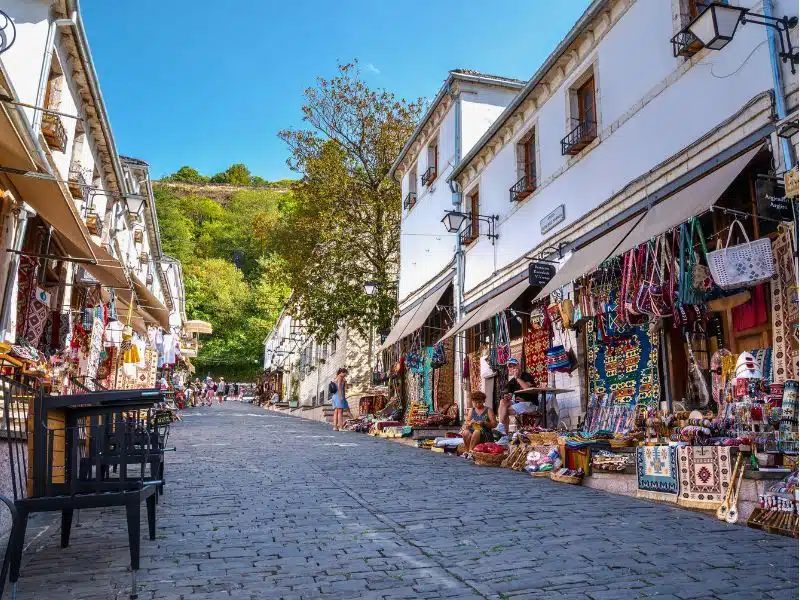
9. Marvel at the Ottoman Architecture of Berat
Known as the “City of a Thousand Windows”, Berat is one of Albania’s most visually striking destinations. With its white-washed houses stacked along the hillsides, adorned with numerous large windows, the city presents a harmonious blend of Ottoman architecture and natural beauty.
As a UNESCO World Heritage Site, Berat offers visitors a unique chance to explore historic neighborhoods, ancient churches, mosques, and museums.
What to Expect
Iconic Ottoman architecture: Wander through the Mangalem and Gorica quarters, where the stone-and-wood houses cascade down the hillside, creating the illusion of countless windows gazing out across the Osum River. These houses, built during the Ottoman era, are renowned for their symmetrical windows, sloped roofs, and stone facades.
Berat Castle (Kalaja e Beratit): Unlike most castles, Berat Castle is a living fortress, still home to residents who occupy houses within its ancient walls. Dating back to the 4th century BC, the castle complex contains Byzantine churches, Ottoman mosques, and charming cobblestone streets. The panoramic views from the top are nothing short of breathtaking.
Onufri National Museum: Located within the castle grounds, this museum houses an impressive collection of icons and religious artifacts. Named after Onufri, Albania’s most celebrated icon painter, the museum provides insight into the country’s artistic heritage.
Ethnographic Museum: Housed in a well-preserved Ottoman-era mansion, this museum showcases traditional Albanian household items, clothing, tools, and furniture, offering visitors a glimpse into the daily life of the region’s past inhabitants.
Getting to Berat
From Tirana: Berat is accessible by bus or car from Tirana, with the journey taking approximately 2 to 2.5 hours. Buses depart frequently from Tirana’s South Bus Station.
From Durrës: A bus or car journey from Durrës takes around 2 hours.
By Car: Driving to Berat allows for greater flexibility and the opportunity to explore the picturesque countryside along the way.
Local Delicacy to Try
While exploring Berat, don’t miss the chance to taste qifqi, a regional specialty consisting of rice balls mixed with eggs, herbs, and sometimes meat, shaped into spheres and then fried until golden brown. Often seasoned with mint, black pepper, and other aromatic spices, qifqi offers a burst of flavor with every bite. The dish is commonly found in traditional restaurants and family-run eateries throughout the city.
Berat Travel Tips
Accommodation options: Consider staying in a converted Ottoman house for a truly authentic experience. Guesthouses are often run by local families who are eager to share their culture and stories.
Best time to visit: Spring and early autumn offer pleasant temperatures and fewer crowds.
Wear comfortable shoes: The cobbled streets of Berat’s castle and old quarters can be uneven, so sturdy footwear is recommended.
Explore the bazaar: Located at the foot of the Mangalem quarter, the Berat Bazaar is a lively spot to shop for local crafts, textiles, and delicious homemade jams and honey.
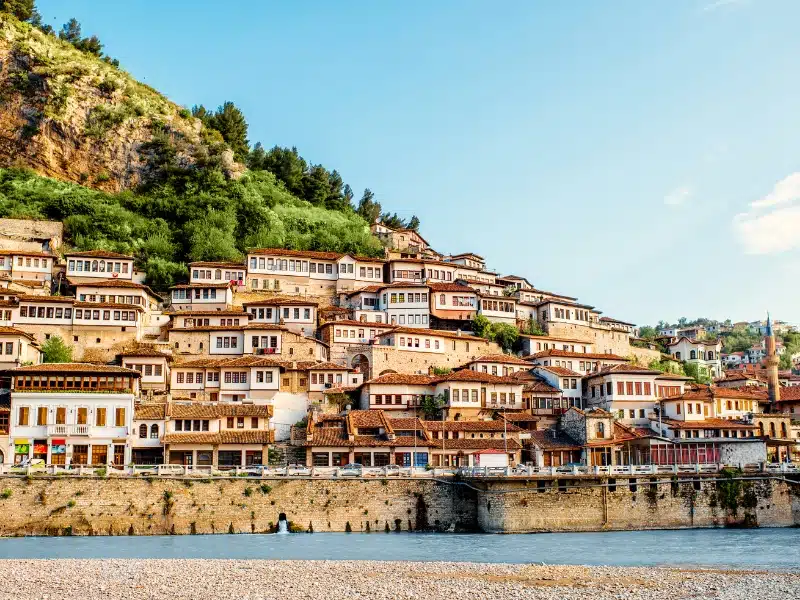
10. Traverse the Lively Streets of Shkodër
Shkodër, often regarded as the cultural capital of Albania, is a captivating city where history, art, and modernity seamlessly blend. On the shores of Lake Shkodër and at the gateway to the Albanian Alps, Shkodër offers visitors colorful streets, charming cafes, and rich artistic heritage, and is one of Albania’s most culturally dynamic destinations.
What to Expect
Rozafa Castle: Perched high above the city, Rozafa Castle offers stunning panoramic views of Shkodër, Lake Shkodër, and the confluence of the Buna and Drin rivers. This ancient fortress, with roots dating back to the Illyrian period, is steeped in legend and history. According to local folklore, the castle’s foundations were built upon the tragic sacrifice of a young woman named Rozafa. Today, visitors can explore the ruins, watchtowers, and on-site museum that highlights the region’s rich past.
Historic city center: Wander through Pedonale (Rruga Kolë Idromeno), a charming pedestrian street lined with cafes, shops, and colorful facades. The lively atmosphere is complemented by street performers, musicians, and artists, especially during local festivals.
Marubi National Museum of Photography: A must-visit for art enthusiasts, this museum houses an extensive collection of historical photographs dating back to the 19th century. Founded by Pietro Marubi, Albania’s first photographer, the museum showcases the evolution of Albanian society through its impressive archives.
Art festivals: Shkodër is famous for its thriving art scene. Keep an eye out for the Lake Day Festival, Shkodra Jazz Festival1, and other art exhibitions that highlight the city’s creative spirit.
Getting to Shkodër
From Tirana: Shkodër is easily accessible by bus or car from Tirana, with a journey time of approximately 2 hours. Buses depart regularly from Tirana’s Regional Bus Terminal.
From Montenegro: Shkodër is a convenient stop for travelers coming from Podgorica, Montenegro. The drive takes about 1.5 hours, and buses also run between the two cities.
By Car: Renting a car offers greater flexibility to explore nearby attractions, including Lake Shkodër and the Albanian Alps.
Local Delicacy to Try
During your visit, indulge in shapkat, a delicious local pastry made from cornmeal, yogurt, cheese, and sometimes spinach or other seasonal vegetables. Baked to golden perfection, shapkat is both hearty and comforting – a wonderful taste of Shkodër’s rustic culinary traditions. You can find shapkat at traditional restaurants and local bakeries, especially those located near the castle and along the main pedestrian street.
Shkodër Travel Tips
Best time to visit: Spring and autumn offer pleasant weather and vibrant cultural events.
Explore Lake Shkodër: Take a boat trip on the largest lake in the Balkans, which offers opportunities for bird-watching, swimming, and kayaking.
Stay overnight: While Shkodër is often visited as a day trip, staying overnight allows you to experience the city’s lively nightlife and relaxed atmosphere.
Visit Mesi Bridge: Just outside the city, this Ottoman-era stone bridge spans the Kir River and offers stunning views of the surrounding countryside.
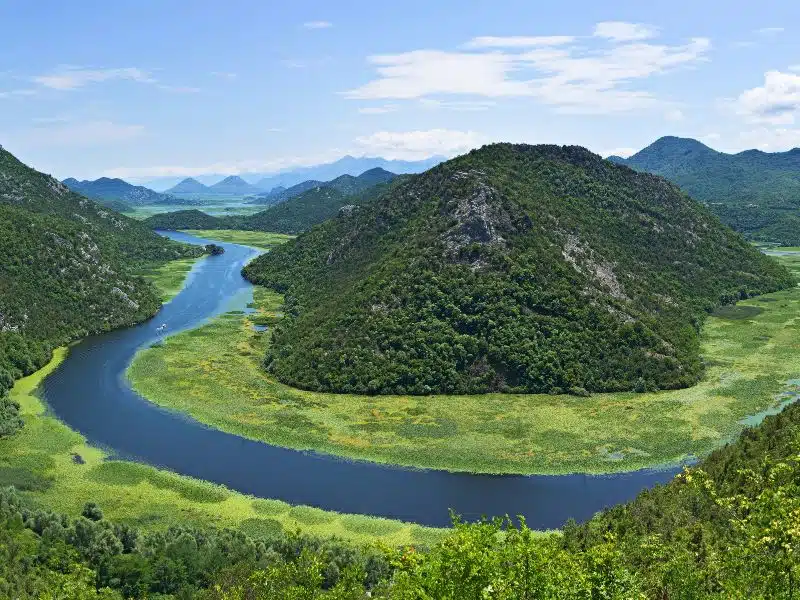
11. Unwind in the Thermal Waters of Bënja
Located near the charming town of Përmet, the thermal waters of Bënja offer a rejuvenating escape amid the natural beauty of southern Albania. Known for their therapeutic properties, these natural hot springs are surrounded by dramatic mountain landscapes, lush greenery, and the tranquil flow of the Lengarica River.
What to Expect
Thermal pools: The area features a series of natural hot springs with temperatures ranging from 30°C to 40°C (86°F to 104°F). The mineral-rich waters are believed to offer benefits for various ailments, including skin conditions, joint pain, and respiratory issues.
Spectacular scenery: While soaking in the warm pools, enjoy views of the majestic Nemerçka Mountains and the nearby Lengarica Canyon, known for its stunning rock formations and crystal-clear waters.
Lengarica Canyon: After enjoying the thermal waters, take a walk along this impressive canyon, with its high stone walls and natural arches. For the more adventurous, guided tours offer the chance to explore the canyon via rafting or hiking.
Ottoman Bridge (Kadiut Bridge): Adding a touch of history to your visit, the stone bridge of Kadiut, built during the Ottoman period, spans the Lengarica River near the hot springs. It serves as a picturesque backdrop and a popular spot for photography.
Getting to Bënja
From Gjirokastër: Bënja is located about 1.5 hours by car from Gjirokastër. Buses run from Gjirokastër to Përmet, followed by a short taxi ride or hike to the springs.
From Tirana: The journey from Tirana to Bënja takes approximately 4.5 hours by car or bus. Buses to Përmet depart from Tirana’s South Bus Station.
By Car: Driving offers the most convenient and scenic route, with the opportunity to explore other nearby attractions such as Përmet’s Old Town and the Vjosa River.
Local Delicacy to Try
As you soak in the soothing thermal waters, make sure to sample qifqi, a regional specialty of the Përmet and Gjirokastër areas. These savory rice balls are flavored with herbs like mint and parsley, bound with eggs, and lightly fried to perfection. Often served as an appetizer or snack, qifqi pairs perfectly with a refreshing glass of local white wine or a traditional drink like raki.
Bënja Travel Tips
Stay overnight in Përmet: Known as the “City of Flowers,” Përmet offers charming guesthouses, cozy restaurants, and friendly locals. It’s also famous for its organic produce, honey, and wine.
Best time to visit: While the hot springs can be enjoyed year-round, spring and autumn offer the most comfortable temperatures for hiking and exploring the surrounding area.
Prepare for basic facilities: The site is mostly natural and undeveloped, so bring towels, swimwear, and refreshments.
Hiking opportunities: Combine your visit to the springs with a hike through Lengarica Canyon, which offers breathtaking scenery and opportunities for wild swimming.
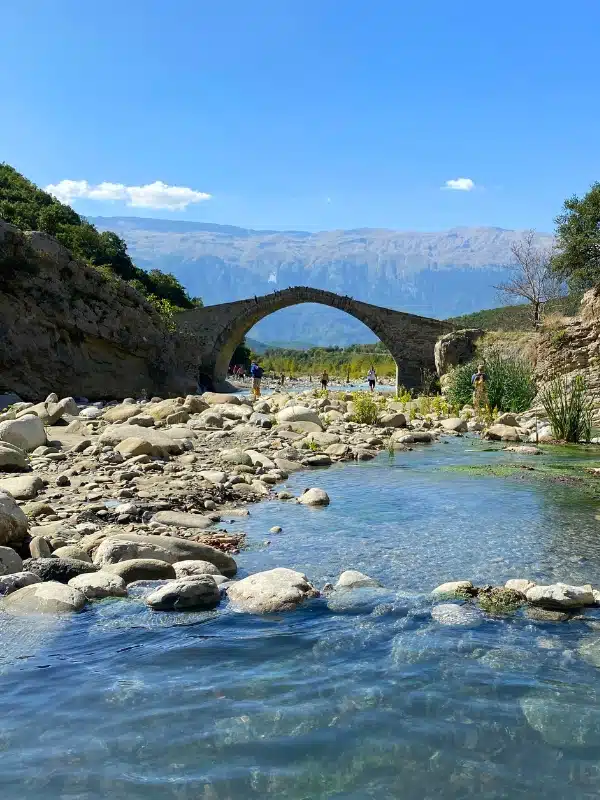
12. Witness the Mesmerizing Beauty of Syri i Kaltër
Syri i Kaltër, or the “Blue Eye,” is one of Albania’s most stunning natural wonders. Located near Muzinë, between Saranda and Gjirokastër, this vibrant natural spring enchants visitors with its hypnotic shades of turquoise and deep blue.
The spring’s intense color and clarity resemble an eye’s iris, giving it its evocative name. With water gushing from a depth of over 50 meters (164 feet), the Blue Eye remains one of the most fascinating and mysterious natural sites in Albania.
What to Expect
The Blue Eye spring: Prepare to be captivated by the brilliant shades of blue and green that shimmer from the spring’s depths. The water is so clear that you can see vegetation and stones beneath the surface. Its striking color changes subtly with sunlight, creating a mesmerizing effect.
Cooling atmosphere: The site is surrounded by a dense forest of oaks and pines, offering a refreshing respite from the heat, especially during the hot summer months. Wooden walkways and shaded paths make exploration easy and enjoyable.
Swimming: While swimming is technically prohibited due to the powerful current and environmental concerns, some visitors still take a dip in the icy waters. However, it’s best to respect the site’s natural beauty and regulations.
Photography: This site is a paradise for photographers. From capturing the vivid blues of the spring to the lush greenery of the forest, the opportunities for breathtaking shots are endless.
Getting to the Blue Eye
From Sarandë: The Blue Eye is located approximately 25 kilometers (16 miles) from Sarandë – a drive of about 30 minutes. Organized tours, taxis, or car rentals are popular options for reaching the site.
From Gjirokastër: Located about 35 kilometers (22 miles) from Gjirokastër, it takes around 45 minutes by car. The scenic drive offers lovely views of the surrounding landscape.
Tours available: There are guided day trips to the Blue Eye often combined with visits to other nearby attractions such as Butrint or Ksamil.
Local Delicacies to Try
While visiting Syri i Kaltër, don’t miss the chance to try some authentic Albanian dishes at nearby tavernas or restaurants. Fasule të Skuqura is a hearty dish of sautéed beans, often cooked with garlic, onions, tomatoes, and spices and Fërgesë is a traditional dish made with peppers, tomatoes, cottage cheese, and sometimes meat.
Blue Eye Travel Tips
Combine with nearby attractions: Make the most of your trip by visiting Butrint National Park or the beaches of Ksamil, both of which are conveniently located near Sarandë.
Best time to visit: Spring and early autumn offer the most pleasant temperatures and fewer crowds. During the peak summer season, the site can become quite busy.
Bring snacks and water: While there are small cafes near the entrance, it’s advisable to bring your own provisions if you plan to spend a lot of time exploring.
Respect the environment: To help preserve the natural beauty of the Blue Eye, avoid littering, swimming, or disturbing the vegetation.
RELATED POST: Blue Eye Albania: Visit Sarandë & Theth Natural Pools
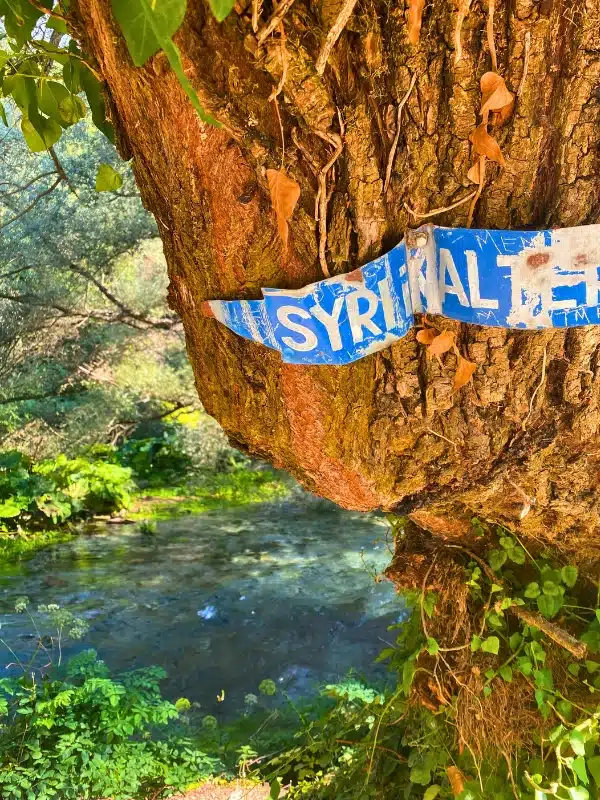
13. Embark on a Culinary Adventure in Lezhë
Lezhë, a charming town in northwestern Albania, is a hidden gem brimming with history, culture, and incredible culinary traditions. Once an important Illyrian city and later a strategic Venetian stronghold, Lezhë is rich in heritage and home to delicious local dishes that reflect its agricultural bounty and rustic flavors.
What to Expect
Lezhe Castle (Kalaja e Lezhës): Perched atop a hill overlooking the town, Lezhe Castle dates back to the 8th century and offers panoramic views of the Adriatic coast, the Drin River, and the surrounding fertile plains. Its ancient ruins include walls, fortifications, and a chapel – remnants of various civilizations that once controlled this strategic point.
Skanderbeg’s Memorial: Pay homage to Albania’s national hero, Gjergj Kastrioti Skanderbeg, whose tomb and memorial complex are located in the heart of Lezhë. The site serves as a reminder of Albania’s fierce resistance against Ottoman invasion.
Local culture: Lezhë’s rustic charm is best experienced through its markets, eateries, and vibrant local events. The town offers an authentic Albanian experience away from the more tourist-heavy destinations.
Getting to Lezhë
From Tirana: Lezhë is easily accessible by bus or car from Tirana, with a journey time of approximately 1.5 hours. Buses depart frequently from Tirana’s Regional Bus Terminal.
From Shkodër: Located just 50 kilometers (31 miles) south of Shkodër, Lezhë can be reached by bus or car in about 1 hour.
By Car: Driving provides the flexibility to explore surrounding attractions, including the scenic beaches of Shengjin and the fertile farmlands of the region.
Local Delicacies to Try
This region is known for its hearty, rustic dishes that highlight fresh, local ingredients.
Tava e lëngut: This savory, slow-cooked dish features tender meat (often lamb or veal) simmered with vegetables, garlic, and spices. The resulting broth is rich, flavorful, and deeply satisfying. Served in clay pots, tava e lëngut is perfect for those seeking an authentic taste of northern Albanian cuisine.
Peta me mish: Another popular dish in Lezhë, this layered pie is made with homemade dough, minced meat, onions, and herbs. Baked to golden perfection, it’s a comforting meal best enjoyed with a side of fresh salad and a glass of local wine.
Lezhë Travel Tips
Combine with coastal exploration: Lezhë is conveniently located near the beautiful beaches of Shëngjin, offering a perfect combination of historical exploration and coastal relaxation.
Best Ttime to visit: Spring and early autumn offer pleasant weather and a chance to experience local festivals.
Wear comfortable shoes: Exploring Lezhe Castle requires walking on uneven terrain, so sturdy footwear is recommended.
Stay overnight: While Lezhë can be visited as a day trip, staying overnight allows you to experience the town’s relaxed atmosphere and sample more local dishes.
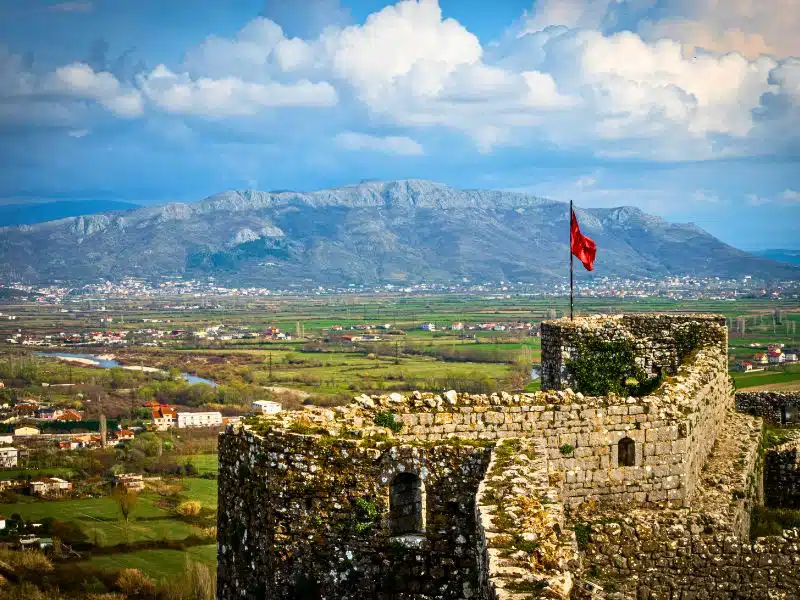
14. Experience Authentic Village Life in Theth
Hidden deep within the rugged beauty of the Albanian Alps, the village of Theth offers an unforgettable cultural experience. Located within the Theth National Park, this remote and picturesque settlement is famous for its unspoiled nature, traditional stone houses, and enduring customs. Visiting Theth feels like stepping back in time to experience a simpler way of life surrounded by breathtaking mountain scenery.
What to Expect
Rustic village atmosphere: Theth is a quaint alpine village where locals maintain traditional ways of living. Visitors are often welcomed into family-run guesthouses where warm hospitality, homemade meals, and fascinating stories are shared freely.
Blue Eye of Theth (Syri i Kaltër i Thethit): While less famous than its counterpart near Sarandë, this natural spring is equally beautiful. Located deep within the park, the vibrant blue water emerges from underground caves surrounded by lush greenery. The hike to reach it, passing through forests, meadows, and waterfalls, is part of the magic.
Grunas Waterfall: A spectacular 30-meter-high waterfall located near the village, accessible via a short hike. Its powerful cascade and cool mist offer a refreshing break during a day of exploration.
Valbona-Theth hike: Many visitors complete the stunning trek from Valbona to Theth, a 17-kilometer journey that offers breathtaking views of the Alps, wildflowers, and pristine rivers.
Lock-In Tower (Kulla e Ngujimit): An intriguing relic of Albania’s ancient Kanun laws, this stone tower once served as a place of refuge for men involved in blood feuds. Today, it serves as a museum providing insight into local customs, traditions, and the harsh realities of the past.
Theth Church: A picturesque 17th-century church that sits peacefully in the valley, offering a beautiful contrast against the surrounding mountains.
Getting to Theth
By Car: A newly paved road from Shkodër to Theth makes driving much easier than in the past. The journey takes around 2.5 hours.
By Bus/Minivan (Furgon): Shared taxis and minibuses run daily from Shkodër during the summer months, taking around 3–4 hours depending on road conditions.
From Valbona: Many travelers complete the popular Valbona-Theth hike, which ends in Theth. From there, shared taxis are available to return visitors to Shkodër.
Local Delicacies to Try
A visit to Theth is incomplete without sampling kos me hudhër, a simple and delicious yogurt and garlic dip. Made from freshly churned yogurt, mixed with minced garlic and herbs, this dish is often served with homemade bread or as a side to hearty meat dishes.
Theth Travel Tips
Plan ahead: If you’re doing the Valbona-Theth hike, arrange transportation and accommodation in advance, particularly during peak season.
Best time to visit Theth: Theth is most accessible from late May to early October. Outside of these months, heavy snowfall closes the road most years.
Pack for the outdoors: Even during summer, nights can be chilly. Bring warm clothing, comfortable hiking shoes, and waterproof gear.
Stay overnight: To fully experience Theth’s charm, stay at a local guesthouse. Many offer guided tours, home-cooked meals, and authentic Albanian hospitality.
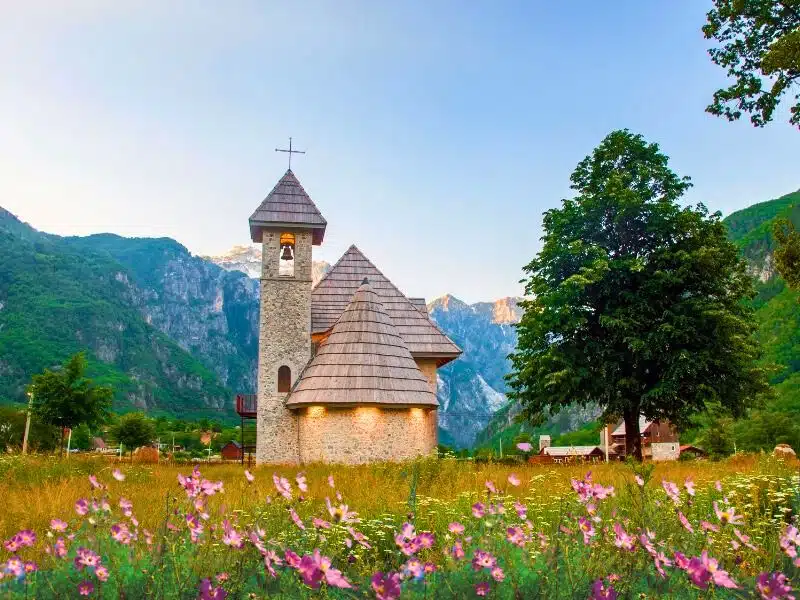
15. Rafting on the Vjosa River
Known as Europe’s last wild river, the Vjosa River offers a thrilling and unforgettable rafting experience through one of Albania’s most pristine natural landscapes. Flowing uninterrupted for over 270 kilometers (168 miles) from the Pindus Mountains in Greece to the Adriatic Sea, the Vjosa is celebrated for its wild beauty, crystal-clear waters, and diverse ecosystems.
Rafting along this majestic river offers not only adrenaline-pumping excitement but also a rare opportunity to connect with Albania’s untouched wilderness.
What to Expect
Spectacular scenery: As you navigate the rapids and calm sections, you’ll be surrounded by breathtaking landscapes that include steep gorges, lush forests, and rolling hills. The Vjosa River carves its way through some of the most beautiful and remote areas of Albania, providing unparalleled views of the natural environment.
Wildlife spotting: The Vjosa River basin is home to hundreds of plant and animal species, many of which are rare or endangered. Birdwatchers can spot eagles, kingfishers, and herons, while lucky rafters might glimpse otters and other wildlife along the riverbanks.
Beginners and families rafting: Gentler sections of the river, particularly near the town of Përmet, offer mild rapids and smooth currents, making them ideal for beginners or families seeking a more relaxed experience.
Adventurous rafters: Those seeking a thrill can tackle Class III and IV rapids, particularly during the spring months when melting snow increases the river’s flow and intensity.
Cultural encounters: Along the journey, you may stop at remote villages where locals are eager to share their traditions, cuisine, and stories. This adds a special cultural dimension to your adventure.
Getting to the the Vjosa River
From Tirana: The most popular starting point for rafting on the Vjosa River is Përmet, located approximately 3.5 hours (240 km / 149 miles) south of Tirana. Buses and cars are the most convenient ways to reach Përmet.
From Gjirokastër: Përmet is just an hour’s drive (60 km / 37 miles) from Gjirokastër, making it a convenient day trip or overnight excursion.
Guided tours: Several adventure companies operate guided rafting tours along the Vjosa, particularly from Përmet. These tours provide safety equipment, experienced guides, and all necessary arrangements.
Local Delicacies to Try
After an exhilarating day on the water, indulge in some of the region’s most beloved dishes. Gliko is a local specialty consisting of fruit preserves, often served with a glass of water as a welcoming gesture. Varieties include fig, walnut, and cherry, all rich in flavor and prepared with love by the local community.
Byrek Me Spinaq is a flaky pastry filled with spinach and feta cheese, perfect for a hearty snack or light meal after rafting, and Tave Kosi is a traditional Albanian casserole made with lamb, yogurt, eggs, and rice, providing the perfect comfort food to warm you up after a day on the river.
Vjosa River Travel Tips
Best time to visit: The ideal time for rafting is during the spring and early summer (April to June) when the river’s flow is strongest, providing the most exciting rapids. Autumn also offers good conditions with fewer crowds.
What to bring: Wear quick-drying clothing, water shoes, sunscreen, and a hat. Most tour companies provide life jackets, helmets, and wetsuits if necessary.
Safety first: Always choose a licensed and reputable tour company. Listen carefully to your guide’s instructions and never attempt difficult rapids without proper training and equipment.
Combine with other activities: The Vjosa River region is ideal for hiking, birdwatching, and visiting the nearby Bënja thermal baths – a perfect way to relax your muscles after rafting.
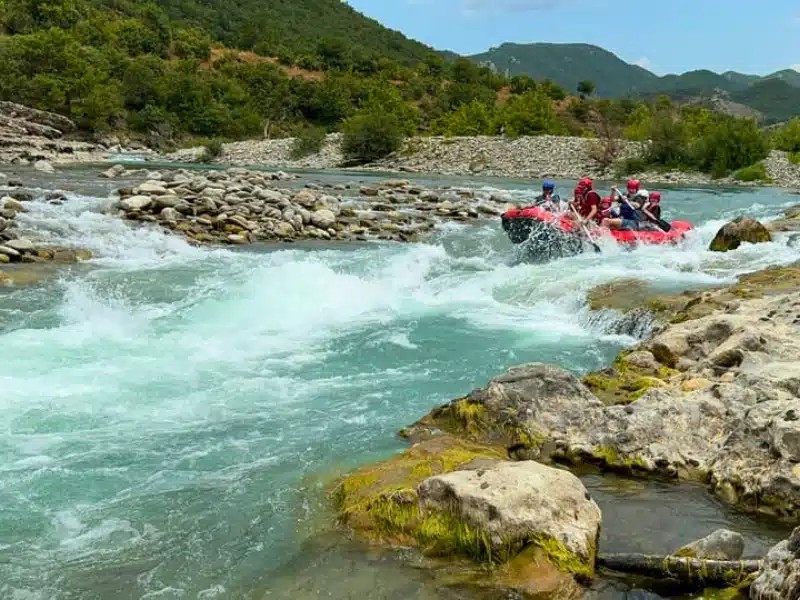
16. Drive the Llogara Pass
Widely regarded as one of Albania’s most scenic roads and even featured on Top Gear, the Llogara Pass is a spectacular mountain pass that offers breathtaking views of the Ionian Sea, rugged peaks, and lush forests.
Connecting the northern Dukat Valley in Llogara National Park with the Albanian Riviera in southern Albania, this drive is a must for adventure enthusiasts and is one of our top driving roads in Europe.
What to Expect
Jaw-dropping views: The road ascends to a height of 1,043 meters (3,422 feet) above sea level, offering sweeping vistas of the Ceraunian Mountains and the sparkling Ionian Sea below. As you make your way along the winding road, be prepared for hairpin turns, dramatic cliffs, and panoramic lookouts that will leave you breathless.
Llogara National Park: The pass runs through the Llogara National Park, a pristine area known for its dense pine forests, diverse wildlife, and cool, refreshing air. Stop along the way for a hike or picnic, or simply enjoy the peaceful natural surroundings.
Albanian Riviera: After descending the pass, you’ll be greeted by the stunning Albanian Riviera, famous for its turquoise beaches, charming villages, and lively coastal culture. Towns like Dhërmi, Himarë, and Ksamil are easily accessible from the end of the pass.
Photography opportunities: The Llogara Pass offers some of the best photo spots in Albania. Whether you’re capturing the rugged mountain landscapes, the deep blue sea, or the winding road itself, this drive is a photographer’s dream.
Getting to the Llogara Pass
From Tirana: By car, the drive to the Llogara Pass takes approximately 3 hours (140 km / 87 miles). Following the SH8 highway from Vlora toward the Albanian Riviera will take you directly through the pass.
From Vlorë: The Llogara Pass is located about 35 kilometers (22 miles) south of Vlorë, making it a convenient and scenic day trip for those staying in the coastal city.
Renting a car is the most popular way to experience the pass. The road is in good condition but requires careful driving due to its sharp curves and high elevation.
Local Delicacies to Try
During your journey, make a stop at one of the mountain-side restaurants or tavernas near the top of the pass. A must-try dish is mish pule në çerep – slow-cooked chicken baked in a clay pot, often served with fresh vegetables and potatoes. The fresh air and mountain views make this hearty meal even more enjoyable.
Llogara Pass Travel Tips
Combine with a Riviera road trip: The Llogara Pass is part of the stunning SH8 highway, which continues along the Albanian Riviera. Consider combining your drive with stops in Dhërmi, Himarë, and Ksamil for a full coastal experience.
Best time to visit: The Llogara Pass is accessible year-round, but the clearest and most beautiful views are typically during the spring and early autumn months. Summer can be quite busy, while winter occasionally sees fog or icy conditions.
Drive carefully: The road is well-paved but includes sharp turns and steep drops. Drive cautiously, especially during poor weather or heavy traffic.
Photography stops: Plan to pull over at designated viewpoints along the route for photos and to simply take in the incredible scenery.
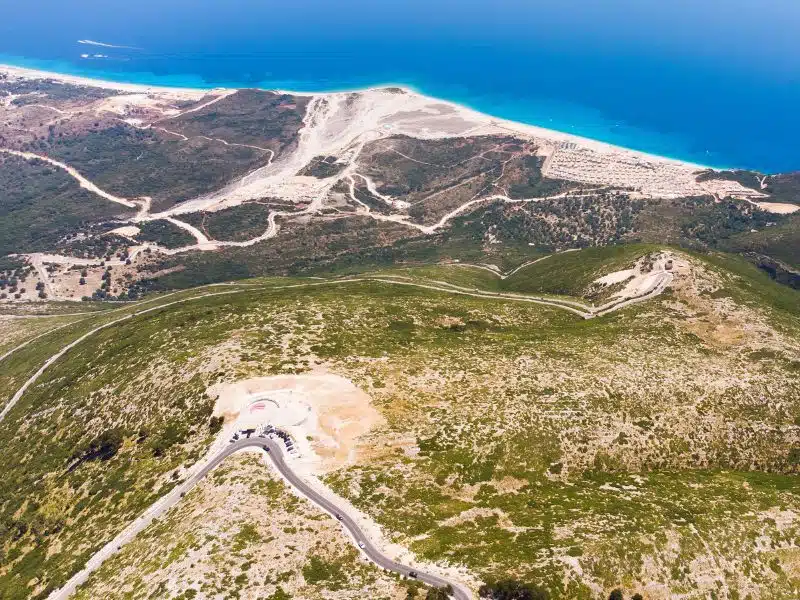
17. Explore Apollonia Archaeological Park
Step back in time at Apollonia Archaeological Park, one of Albania’s most significant and underrated ancient sites. Located near the city of Fier, Apollonia was established by Greek colonists from Corinth and Corfu in 588 BC.
Named after the god Apollo, this once-thriving city grew rapidly into an important economic and cultural hub, boasting a renowned school of philosophy during the Roman era. Today, visitors can explore its well-preserved ruins surrounded by rolling hills and olive groves, offering a serene and evocative experience.
What to Expect
Rich history: Apollonia served as a powerful city-state during its peak, minting its own currency and participating actively in the Mediterranean trade networks. After coming under Roman control in 229 BC, it continued to flourish as a cultural and educational center. It’s believed that Octavian (the future Emperor Augustus) studied philosophy here before returning to Rome to assume power.
Bouleuterion (council house): The most iconic structure of Apollonia, this elegant facade of 2nd-century BCE administrative buildings is defined by stately Doric columns. The restored pillars are particularly impressive against the verdant landscape.
Theatre: This ancient Greek theatre once seated thousands and offers spectacular views of the surrounding countryside. Its ruins, though partially restored, still convey the grandeur of its original design.
Nymphaeum: A monumental water fountain that served both decorative and practical purposes, showcasing the sophisticated engineering of the ancient city.
Roman villa remains: Explore the foundations of luxurious Roman villas adorned with mosaic floors and intricate architectural details.
Apollonia Monastery and Museum: Within the archaeological park, you’ll find the Monastery of Saint Mary, built in the 13th century. It houses a small but fascinating museum featuring artifacts discovered during excavations, including pottery, coins, sculptures, and inscriptions.
Getting to Apollonia
From Tirana: Apollonia is located about 120 kilometers (75 miles) south of Tirana. The drive takes approximately 2 hours by car.
From Fier: Apollonia is just 12 kilometers (7.5 miles) from Fier, a 20-minute drive. Taxis and buses from Fier make it a convenient day trip.
By Car: Renting a car is the most practical way to reach Apollonia. The roads are generally in good condition, and the park has a designated parking area.
Local Delicacies to Try
While exploring Apollonia, make sure to try byrek me mish, a savory pastry filled with minced meat, onions, and herbs. It’s often baked in a wood-fired oven, resulting in a crispy golden crust with a rich, flavorful filling.
Appolonia Travel Tips
Photography opportunities: The park’s scenic surroundings and ancient structures make it a prime location for photography, especially during sunrise or sunset.
Best time to visit: The park is accessible year-round, but the best times to visit are spring (April–June) and autumn (September–October) when the weather is mild and pleasant.
Wear comfortable shoes: The terrain is uneven, and you’ll be doing a lot of walking to explore all the ruins.
Bring water and snacks: While there are some small cafes nearby, it’s advisable to bring your own refreshments if you plan to explore the park extensively.
Guided tours available: Hiring a local guide can enhance your visit by providing in-depth historical context and showing you hidden gems within the site.
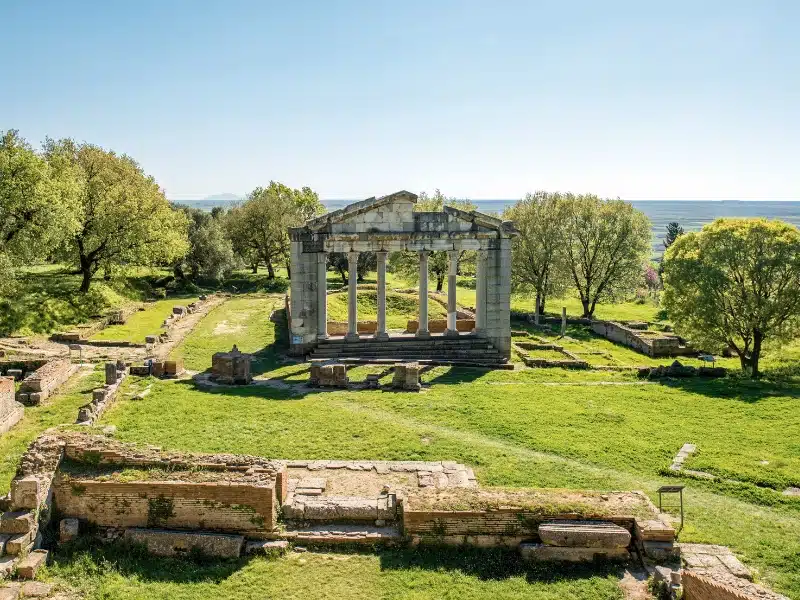
18. Take the Dajti Express Cable Car
For a scenic escape from the bustling city of Tirana, a trip to Mount Dajti National Park is an absolute must. Located just 25 kilometers (15.5 miles) east of Tirana, this popular destination offers breathtaking views, outdoor activities, and fresh mountain air—all just a short journey away from the capital.
What to Expect
Dajti Express Cable Car: The Dajti Express is the longest cable car in the Balkans, covering a distance of 4.7 kilometers (2.9 miles) in about 15 minutes. During the ascent, enjoy panoramic views of Tirana, the Adriatic Sea, and the lush forests of Mount Dajti. The cabins are comfortable and spacious, providing a relaxing experience as you glide above picturesque landscapes.
Mount Dajti: Upon reaching the summit at 1,611 meters (5,285 feet) above sea level, you are greeted with cool mountain breezes, dense pine forests, and unparalleled vistas. On clear days, the view stretches across the entire Tirana plain and beyond.
Adventure activities: The summit area offers more than just spectacular views. Try paragliding, hiking, horseback riding, or mountain biking. During winter, the park occasionally receives snowfall, transforming it into a beautiful winter wonderland.
Dajti Ekspres complex: At the top station, you’ll find a hotel, restaurant, and observation deck. The Ballkoni Dajti Restaurant is particularly popular, offering traditional Albanian dishes and international cuisine with a stunning view from its glass-walled dining area.
Getting to the Dajti Express Cable Car
By Bus: Take a bus or taxi from Tirana to the Dajti Express Cable Car base station located near the Dajti National Park entrance. Buses leave from the city center regularly, making it a convenient option.
By Taxi: A taxi ride from Tirana’s city center to the cable car station takes around 20–30 minutes.
By Car: If you prefer to drive, parking is available at the base station.
Local Delicacies to Try
While enjoying the views from the top of Mount Dajti, don’t miss the opportunity to try fërgesë tirane, a savory dish made with peppers, tomatoes, cottage cheese, and sometimes liver. This hearty and comforting dish pairs perfectly with fresh bread and a glass of local wine. The Ballkoni Dajti Restaurant serves excellent fërgesë along with other traditional dishes.
Dajti Express Travel Tips
Book in advance: During peak tourist seasons, especially in summer, it’s wise to arrive early or book tickets in advance to avoid long wait times.
Best time to visit: Mount Dajti is accessible year-round, but the best views are during the clear, sunny days of spring and autumn.
Wear comfortable clothing: Temperatures at the summit are often cooler than in Tirana, so bring a light jacket or sweater even during the summer months.
Photography opportunities: The views from the top are truly spectacular. Make sure to bring a camera or smartphone to capture the sweeping vistas.

These captivating experiences offer a kaleidoscope of Albania’s essence, unveiling layers of history, natural beauty, and cherished traditions.
Plan your journey wisely with our Albania travel guide and you’ll find yourself immersed in a world of wonder that’s both unique and enchanting.
Remember to seize opportunities to engage with locals, taste authentic cuisine, and participate in cultural events for an unforgettable adventure.
Frequently Asked Questions about Albania
Q1: Is Albania a safe destination for travelers?
A: Absolutely. Albania takes pride in its safety and hospitality, making it a welcoming place for tourists. Crime rates are low, contributing to a secure environment.
Q2: What’s the best time to visit Albania?
A: Spring (April to June) and fall (September to October) are ideal for pleasant weather and fewer crowds. However, each season offers its own unique charm.
Q3: Can I communicate in English in Albania?
A: While Albanian is the official language, English is spoken in tourist areas and major cities. Learning a few local phrases can enhance your interactions.
Q4: Are credit cards widely accepted?
A: Credit cards are accepted in larger establishments, but it’s wise to carry cash, especially in rural areas. ATMs are readily available in urban centers.
Q5: What’s the local currency in Albania?
A: The local currency is the Albanian Lek (ALL), but many places will accept euros. As a rule of thumb, 100 lek will be converted to 1 euro, whereas the official exchange rate is more like 0.8c to 100 lek. You’ll find currency exchange offices in major cities and airports.
Looking for more travel inspiration? Check out these top posts…
16 of the Best Travel Destinations in January
Our 60 Before 60 Travel Bucket List
The 16 Best Second Cities in Europe You Shouldn’t Miss
Adventure Travel Bucket List: 15 Epic Experiences in Europe
Travel Trends 2026: The Year of Mindful Escapes and Meaningful Journeys
The Ultimate Europe Travel Bucket List: 15 Classic Experiences to Inspire Your Next Trip
Love it? Pin it!
